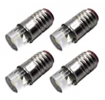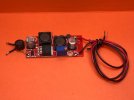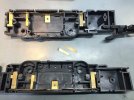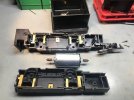I recently bought a LGB circus engine # 24171. The front light works sometimes and sometimes does not work. I do lap time trials to see how the engines perform. When the light is on the engine runs slower. When the light was off the engine made the lap quicker, like two times faster. Looking for input as to why this would happen and possible fixes. Thanks
LGB engine runs slower when front light is on.
- Thread starter zman50
- Start date
You are using an out of date browser. It may not display this or other websites correctly.
You should upgrade or use an alternative browser.
You should upgrade or use an alternative browser.
My track oval is 24ft by 8ft, I use starter set transformer with wires to connect to track from starter set also. I have done time tests on the same type of engines 0-4-0 also from starter sets and all do ok making it around the oval in fairly equal times with their lights on. But this circus engines takes 2x as long when its light is on, but runs equal to the others when light is off. The light goes on by itself and off by itself with no rhyme or reason.Sounds like you may be near the current limit for your controller, or you have a lot of poor rail joints. - Both assuming you are track power?
What controller/supply are you using?
How long is your track?
How do you feed power to your track?
PhilP
So it would appear to be problems with just this loco..
How 'tired' does the loco look? - Generally tatty, worn skates and plating on the wheels, also look at the backs of the wheels..
Check the tyres are clean.
Check the skates can move up and down freely.
Check the rear faces of the wheels. - They want to be fairly clean.
Check the carbon brushes (that rub on the rear faces of the wheels). - These should not be too worn, and should move freely. Sometimes they get a notch worn on them, from the edge of the holder.
If you have a meter:
Check for continuity along the wheels and skate, each side of the loco. - You should get a 'beep' or other indication, between the wheels and skate, along each side of the loco.
There should not be masses of oil, on the bottom plate of the motor block.
Nor should there be masses of old filthy grease (and/or possibly muck) around the axles.
If there is a model number on the underside of the loco, what is it?
If there is a circular gold sticker, what are the first and last, of the six digits?
Once we have an idea of the age and condition, we can make more suggestions.
If it is an older model, it may have screw-in bulbs?
A bulb could just be loose in the holder, but should not cause a loco to slow to that extent..
If the motor is really old and worn, then it might be taking enough current (I assume you have the 1Amp starter set controller?) and the lamp is taking it just over the limit of your transformer?
PhilP
How 'tired' does the loco look? - Generally tatty, worn skates and plating on the wheels, also look at the backs of the wheels..
Check the tyres are clean.
Check the skates can move up and down freely.
Check the rear faces of the wheels. - They want to be fairly clean.
Check the carbon brushes (that rub on the rear faces of the wheels). - These should not be too worn, and should move freely. Sometimes they get a notch worn on them, from the edge of the holder.
If you have a meter:
Check for continuity along the wheels and skate, each side of the loco. - You should get a 'beep' or other indication, between the wheels and skate, along each side of the loco.
There should not be masses of oil, on the bottom plate of the motor block.
Nor should there be masses of old filthy grease (and/or possibly muck) around the axles.
If there is a model number on the underside of the loco, what is it?
If there is a circular gold sticker, what are the first and last, of the six digits?
Once we have an idea of the age and condition, we can make more suggestions.
If it is an older model, it may have screw-in bulbs?
A bulb could just be loose in the holder, but should not cause a loco to slow to that extent..
If the motor is really old and worn, then it might be taking enough current (I assume you have the 1Amp starter set controller?) and the lamp is taking it just over the limit of your transformer?
PhilP
Everything is clean and lubed, skates are not worn. Brushes are good. Model # is 24171. 9 and 6 on gold label, what does that mean anyway? Continuity checks ok. The bulb does look like a screw in bulb. Yes 1 amp starter set controller.So it would appear to be problems with just this loco..
How 'tired' does the loco look? - Generally tatty, worn skates and plating on the wheels, also look at the backs of the wheels..
Check the tyres are clean.
Check the skates can move up and down freely.
Check the rear faces of the wheels. - They want to be fairly clean.
Check the carbon brushes (that rub on the rear faces of the wheels). - These should not be too worn, and should move freely. Sometimes they get a notch worn on them, from the edge of the holder.
If you have a meter:
Check for continuity along the wheels and skate, each side of the loco. - You should get a 'beep' or other indication, between the wheels and skate, along each side of the loco.
There should not be masses of oil, on the bottom plate of the motor block.
Nor should there be masses of old filthy grease (and/or possibly muck) around the axles.
If there is a model number on the underside of the loco, what is it?
If there is a circular gold sticker, what are the first and last, of the six digits?
Once we have an idea of the age and condition, we can make more suggestions.
If it is an older model, it may have screw-in bulbs?
A bulb could just be loose in the holder, but should not cause a loco to slow to that extent..
If the motor is really old and worn, then it might be taking enough current (I assume you have the 1Amp starter set controller?) and the lamp is taking it just over the limit of your transformer?
PhilP
I would like to take the bulb out but cannot figure how to release the bulb housing from the base underneath. There are two tabs. Any tips how to do that. ThanksIf the light isn't the original one, it may be too beig a wattage
On the Stainz, the smoke-stack unscrews, and that releases the lamp housing..
Beware the weight.. The stack has to pass through it, and it can move/rotate, when the stack is removed.
Beware the weight.. The stack has to pass through it, and it can move/rotate, when the stack is removed.
Well this engine the front light is in a rectangular box, so even if I remove it from the engine I still won't be able to get to bulb unless I can get the box to release from base. It has two tabs under the base and those two tabs are very tricky to release. Any tips from anyone?On the Stainz, the smoke-stack unscrews, and that releases the lamp housing..
Beware the weight.. The stack has to pass through it, and it can move/rotate, when the stack is removed.
I used a pair of pliers to gently squeeze the 2 tab inwards to release the lamp. You could spray some penetrating oil to assist, however I did not use any as the loco had been in a warm environment.
Thanks I finally got the bulb housing off. I cleaned the inside base and the bulb seems to stay on now, where before it would cut out. The bulb is not as bright as my other engines of the same kind. Do I need a new bulb? Do they make screw in LED bulbs that small? ThanksI used a pair of pliers to gently squeeze the 2 tab inwards to release the lamp. You could spray some penetrating oil to assist, however I did not use any as the loco had been in a warm environment.
I use the standard 18 volt bulb as supplied by LGB. Part No LGB 68501 or Massoth 88360027-5 for a pack of 5Thanks I finally got the bulb housing off. I cleaned the inside base and the bulb seems to stay on now, where before it would cut out. The bulb is not as bright as my other engines of the same kind. Do I need a new bulb? Do they make screw in LED bulbs that small? Thanks
Zman50 - I couldn't find an LGB Parts Diagram for your LGB 24171 Circus Steam Locomotive which originally sold also with a Motorized Circus Tender. Your locomotive was produced during 1994 - 1997. But I did find the Parts Diagram for the LGB 22171 Western Steam Locomotive #17 with Motorized Tender and it was produced during the same timeframe, 1993 - 1995. So, in theory, the LGB Parts Diagram for the 22171 should be similar to your 24171. So, your locomotive has no circuit board to potentially cause the problem. The motor, 18v. smoke unit, and 18v. light are all operated by direct track power from your track. None of the headlights and smokers in these older LGB locomotives without a circuit board with a 5 volts regulator produce much light or smoke until the locomotive is running unrealistically fast around 10 plus volts from the track. So, it appears your headlight was shorting out and now seems to be working okay after you cleaned the bulb and light fixture. Perhaps the bulb was not screwed down all the way. No, a new bulb won't make the headlight brighter. Your option is to replace the 18v. screw bulb with a screw LED bulb that will operate bright even at low speed (low voltage to the track). I sometimes install these type LEDs into customers' LGB locomotives I'm repairing. If you also want the smoker to work well, you could install a DC Boost Regulator that will provide continuous 18 volts to the smoker even at 4.5 volts or more applied to the track from your transformer. You can find more information on various LED bulbs and the DC Boost Regulator on my Website: LGB Trains | Old Dominion Railways | Repairs & DCC Installs | United StatesI recently bought a LGB circus engine # 24171. The front light works sometimes and sometimes does not work. I do lap time trials to see how the engines perform. When the light is on the engine runs slower. When the light was off the engine made the lap quicker, like two times faster. Looking for input as to why this would happen and possible fixes. Thanks


Thanks for all that great explanation, it really helped me understand my engines better. I will check out those led lights on your site. I have one more question now that maybe you can answer. The bottom of this engine has a black plastic plate with four screws. It is easy to remove and get to the gears to clean and grease. I have other engines though that look the same but the plate has a bracket across side to side and it connects to the wheel rods. This looks very scary to try and take apart. Why is there a difference in how they were made? I would like to get at those gears and clean and lube those engines also but am afraid of breaking something or getting wheels out of sequence. ThanksZman50 - I couldn't find an LGB Parts Diagram for your LGB 24171 Circus Steam Locomotive which originally sold also with a Motorized Circus Tender. Your locomotive was produced during 1994 - 1997. But I did find the Parts Diagram for the LGB 22171 Western Steam Locomotive #17 with Motorized Tender and it was produced during the same timeframe, 1993 - 1995. So, in theory, the LGB Parts Diagram for the 22171 should be similar to your 24171. So, your locomotive has no circuit board to potentially cause the problem. The motor, 18v. smoke unit, and 18v. light are all operated by direct track power from your track. None of the headlights and smokers in these older LGB locomotives without a circuit board with a 5 volts regulator produce much light or smoke until the locomotive is running unrealistically fast around 10 plus volts from the track. So, it appears your headlight was shorting out and now seems to be working okay after you cleaned the bulb and light fixture. Perhaps the bulb was not screwed down all the way. No, a new bulb won't make the headlight brighter. Your option is to replace the 18v. screw bulb with a screw LED bulb that will operate bright even at low speed (low voltage to the track). I sometimes install these type LEDs into customers' LGB locomotives I'm repairing. If you also want the smoker to work well, you could install a DC Boost Regulator that will provide continuous 18 volts to the smoker even at 4.5 volts or more applied to the track from your transformer. You can find more information on various LED bulbs and the DC Boost Regulator on my Website: LGB Trains | Old Dominion Railways | Repairs & DCC Installs | United States
View attachment 296135View attachment 296139
I believe you're referring to the older, first generation of motor blocks produced by LGB.......the infamous "clam shell" motor block. Yes, you must totally disassemble the motor block to access the interior to even grease the gears, replace a motor, etc. You take remove all the wheels, driving rods, and the side screws in the motor block.......when each wheel is removed, the spring and carbon brush will fly out, so be careful as you remove each wheel. Then lay the motor block on it's side and lift the upper side up and away and it will expose the inside gears, motor, etc. Below are photos of a customer's LGB 2050 Steam Tram's clam shell motor block that I recently converted for a DCC sound decoder installation........you can see what one looks like.Thanks for all that great explanation, it really helped me understand my engines better. I will check out those led lights on your site. I have one more question now that maybe you can answer. The bottom of this engine has a black plastic plate with four screws. It is easy to remove and get to the gears to clean and grease. I have other engines though that look the same but the plate has a bracket across side to side and it connects to the wheel rods. This looks very scary to try and take apart. Why is there a difference in how they were made? I would like to get at those gears and clean and lube those engines also but am afraid of breaking something or getting wheels out of sequence. Thanks



Everything is clean and lubed, skates are not worn. Brushes are good. Model # is 24171. 9 and 6 on gold label, what does that mean anyway? .......
I didn't notice anyone replying to your question about the numbers on the gold sticker, so although it's not really relevant to the original problems, just thought I'd chip in!
If an LGB loco has one of the round gold labels with a six digit code on it, the first and last digits tell you the year of manufacture for your particular loco - so if your sticker reads "9xxxx6" then your loco was made in 1996.
A code of "0xxxx3" would be a 2003 manufactured model, and so on.
I'm not exactly sure when these date codes were first applied, but I think you'll find them through a lot of the '90s and then up until 2006, the time of LGB's "troubles" (and eventual acquisition by Marklin).
The other 4 digits on the sticker are also part of the date code system, but the year of manufacture is the important and useful bit.
Jon.
Stickers get dislodged especially when buying used LGB locomotives. An excellent source about LGB locomotives, including year produced, and the factory-installed features is at the Gartenbahn database in Germany. I use it all the time when customers send questions to me about their LGB locomotives, and it's also a possible source for finding the locomotive's User Guide or LGB Parts Diagram when the USA Websites don't have them. The link: GartenBahn DataBaseI didn't notice anyone replying to your question about the numbers on the gold sticker, so although it's not really relevant to the original problems, just thought I'd chip in!
If an LGB loco has one of the round gold labels with a six digit code on it, the first and last digits tell you the year of manufacture for your particular loco - so if your sticker reads "9xxxx6" then your loco was made in 1996.
A code of "0xxxx3" would be a 2003 manufactured model, and so on.
I'm not exactly sure when these date codes were first applied, but I think you'll find them through a lot of the '90s and then up until 2006, the time of LGB's "troubles" (and eventual acquisition by Marklin).
The other 4 digits on the sticker are also part of the date code system, but the year of manufacture is the important and useful bit.
Jon.
Stickers get dislodged especially when buying used LGB locomotives. An excellent source about LGB locomotives, including year produced, and the factory-installed features is at the Gartenbahn database in Germany. I use it all the time when customers send questions to me about their LGB locomotives, and it's also a possible source for finding the locomotive's User Guide or LGB Parts Diagram when the USA Websites don't have them. The link: GartenBahn DataBase
Agreed, stickers can go missing... but if it is there, it's useful information!
The original poster asked what the numbers meant, so I thought I'd answer him.....
Jon.
Agree, I didn't mean to diminish your posting, it's helpful information. I'm just providing another more permanent source of LGB locomotive data.Agreed, stickers can go missing... but if it is there, it's useful information!
The original poster asked what the numbers meant, so I thought I'd answer him.....
Jon.
Thanks!
22171 and 25171 are similar diagrams for the 24171 loco. If you have the 7va power pack then it will overload for motor, light and smoke units all on. I beleive these engines were sold without smoke units and if you have a lit passenger car on the track you can exceed the 7va rating. 7 va means that at 7 volts you may have 1 amp, but at 14 volts you only have 1/2 (.5) amp of power. Note LGB 18 volt smoke units start at 300ma and as they warm up they go to lower current around 200 ma.

